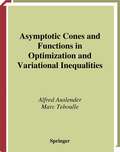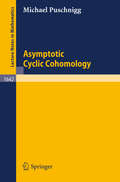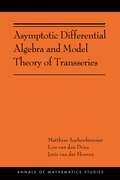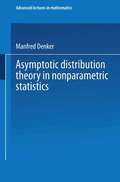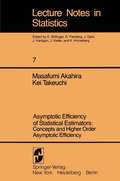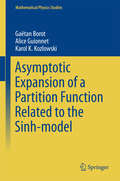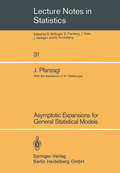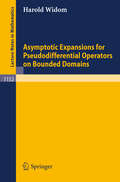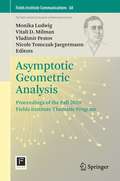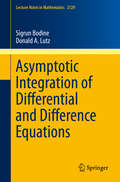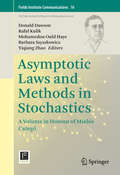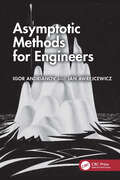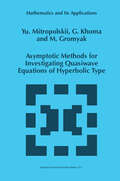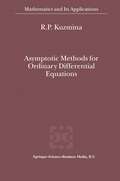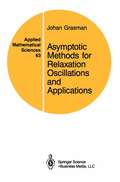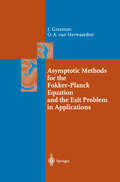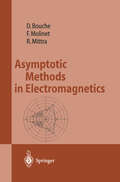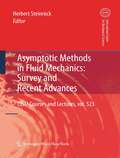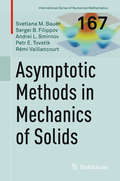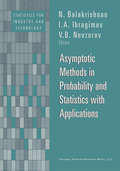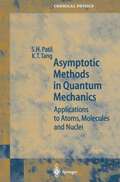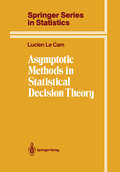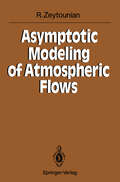- Table View
- List View
Asymptotic Cones and Functions in Optimization and Variational Inequalities (Springer Monographs in Mathematics)
by Alfred Auslender Marc TeboulleThis systematic and comprehensive account of asymptotic sets and functions develops a broad and useful theory in the areas of optimization and variational inequalities. The central focus is on problems of handling unbounded situations, using solutions of a given problem in these classes, when for example standard compacity hypothesis is not present. This book will interest advanced graduate students, researchers, and practitioners of optimization theory, nonlinear programming, and applied mathematics.
Asymptotic Cyclic Cohomology (Lecture Notes in Mathematics #1642)
by Michael PuschniggThe aim of cyclic cohomology theories is the approximation of K-theory by cohomology theories defined by natural chain complexes. The basic example is the approximation of topological K-theory by de Rham cohomology via the classical Chern character. A cyclic cohomology theory for operator algebras is developed in the book, based on Connes' work on noncommutative geometry. Asymptotic cyclic cohomology faithfully reflects the basic properties and features of operator K-theory. It thus becomes a natural target for a Chern character. The central result of the book is a general Grothendieck-Riemann-Roch theorem in noncommutative geometry with values in asymptotic cyclic homology. Besides this, the book contains numerous examples and calculations of asymptotic cyclic cohomology groups.
Asymptotic Differential Algebra and Model Theory of Transseries (PDF)
by Matthias Aschenbrenner Lou van den Dries Joris van der HoevenAsymptotic differential algebra seeks to understand the solutions of differential equations and their asymptotics from an algebraic point of view. The differential field of transseries plays a central role in the subject. Besides powers of the variable, these series may contain exponential and logarithmic terms. Over the last thirty years, transseries emerged variously as super-exact asymptotic expansions of return maps of analytic vector fields, in connection with Tarski's problem on the field of reals with exponentiation, and in mathematical physics. Their formal nature also makes them suitable for machine computations in computer algebra systems.This self-contained book validates the intuition that the differential field of transseries is a universal domain for asymptotic differential algebra. It does so by establishing in the realm of transseries a complete elimination theory for systems of algebraic differential equations with asymptotic side conditions. Beginning with background chapters on valuations and differential algebra, the book goes on to develop the basic theory of valued differential fields, including a notion of differential-henselianity. Next, H-fields are singled out among ordered valued differential fields to provide an algebraic setting for the common properties of Hardy fields and the differential field of transseries. The study of their extensions culminates in an analogue of the algebraic closure of a field: the Newton-Liouville closure of an H-field. This paves the way to a quantifier elimination with interesting consequences.
Asymptotic Distribution Theory in Nonparametric Statistics (Advanced Lectures in Mathematics)
by Manfred DenkerAsymptotic Efficiency of Statistical Estimators: Concepts and Higher Order Asymptotic Efficiency (Lecture Notes in Statistics #7)
by Masafumi Akahira Kei TakeuchiThis monograph is a collection of results recently obtained by the authors. Most of these have been published, while others are awaitlng publication. Our investigation has two main purposes. Firstly, we discuss higher order asymptotic efficiency of estimators in regular situa tions. In these situations it is known that the maximum likelihood estimator (MLE) is asymptotically efficient in some (not always specified) sense. However, there exists here a whole class of asymptotically efficient estimators which are thus asymptotically equivalent to the MLE. It is required to make finer distinctions among the estimators, by considering higher order terms in the expansions of their asymptotic distributions. Secondly, we discuss asymptotically efficient estimators in non regular situations. These are situations where the MLE or other estimators are not asymptotically normally distributed, or where l 2 their order of convergence (or consistency) is not n / , as in the regular cases. It is necessary to redefine the concept of asympto tic efficiency, together with the concept of the maximum order of consistency. Under the new definition as asymptotically efficient estimator may not always exist. We have not attempted to tell the whole story in a systematic way. The field of asymptotic theory in statistical estimation is relatively uncultivated. So, we have tried to focus attention on such aspects of our recent results which throw light on the area.
Asymptotic Expansion of a Partition Function Related to the Sinh-model (Mathematical Physics Studies)
by Gaëtan Borot Alice Guionnet Karol K. KozlowskiThis book elaborates on the asymptotic behaviour, when N is large, of certain N-dimensional integrals which typically occur in random matrices, or in 1+1 dimensional quantum integrable models solvable by the quantum separation of variables. The introduction presents the underpinning motivations for this problem, a historical overview, and a summary of the strategy, which is applicable in greater generality. The core aims at proving an expansion up to o(1) for the logarithm of the partition function of the sinh-model. This is achieved by a combination of potential theory and large deviation theory so as to grasp the leading asymptotics described by an equilibrium measure, the Riemann-Hilbert approach to truncated Wiener-Hopf in order to analyse the equilibrium measure, the Schwinger-Dyson equations and the boostrap method to finally obtain an expansion of correlation functions and the one of the partition function. This book is addressed to researchers working in random matrices, statistical physics or integrable systems, or interested in recent developments of asymptotic analysis in those fields.
Asymptotic Expansions and Summability: Application to Partial Differential Equations (Lecture Notes in Mathematics #2351)
by Pascal RemyThis book provides a comprehensive exploration of the theory of summability of formal power series with analytic coefficients at the origin of Cn, aiming to apply it to formal solutions of partial differential equations (PDEs). It offers three characterizations of summability and discusses their applications to PDEs, which play a pivotal role in understanding physical, chemical, biological, and ecological phenomena. Determining exact solutions and analyzing properties such as dynamic and asymptotic behavior are major challenges in this field. The book compares various summability approaches and presents simple applications to PDEs, introducing theoretical tools such as Nagumo norms, Newton polygon, and combinatorial methods. Additionally, it presents moment PDEs, offering a broad class of functional equations including classical, fractional, and q-difference equations. With detailed examples and references, the book caters to readers familiar with the topics seeking proofs or deeper understanding, as well as newcomers looking for comprehensive tools to grasp the subject matter. Whether readers are seeking precise references or aiming to deepen their knowledge, this book provides the necessary tools to understand the complexities of summability theory and its applications to PDEs.
Asymptotic Expansions for General Statistical Models (Lecture Notes in Statistics #31)
by Johann Pfanzagl0.1. The aim of the book Our "Contributions to a General Asymptotic Statistical Theory" (Springer Lecture Notes in Statistics, Vol. 13, 1982, called "Vol. I" in the following) suggest to describe the local structure of a general family ~ of probability measures by its tangent space, and the local behavior of a functional K: ~ ~~k by its gradient. Starting from these basic concepts, asymptotic envelope power functions for tests and asymptotic bounds for the concentration of estimators are obtained, and heuristic procedures are suggested for the construction of test- and estimator-sequences attaining these bounds. In the present volume, these asymptotic investigations are carried one step further: From approximations by limit distributions to approximations by Edgeworth expansions, 1 2 adding one term (of order n- / ) to the limit distribution. As in Vol. I, the investigation is "general" in the sense of dealing with arbitrary families of probability measures and arbitrary functionals. The investigation is special in the sense that it is restricted to statistical procedures based on independent, identically distributed observations. 2 Moreover, it is special in the sense that its concern are "regular" models (i.e. families of probability measures and functionals which are subject to certain general conditions, like differentiability). Irregular models are certainly of mathematical interest. Since they are hardly of any practical relevance, it appears justifiable to exclude them at this stage of the investigation.
Asymptotic Expansions for Pseudodifferential Operators on Bounded Domains (Lecture Notes in Mathematics #1152)
by Harold WidomAsymptotic Geometric Analysis: Proceedings of the Fall 2010 Fields Institute Thematic Program (Fields Institute Communications #68)
by Monika Ludwig, Vitali D. Milman, Vladimir Pestov and Nicole Tomczak-JaegermannAsymptotic Geometric Analysis is concerned with the geometric and linear properties of finite dimensional objects, normed spaces, and convex bodies, especially with the asymptotics of their various quantitative parameters as the dimension tends to infinity. The deep geometric, probabilistic, and combinatorial methods developed here are used outside the field in many areas of mathematics and mathematical sciences. The Fields Institute Thematic Program in the Fall of 2010 continued an established tradition of previous large-scale programs devoted to the same general research direction. The main directions of the program included:* Asymptotic theory of convexity and normed spaces* Concentration of measure and isoperimetric inequalities, optimal transportation approach* Applications of the concept of concentration* Connections with transformation groups and Ramsey theory* Geometrization of probability* Random matrices* Connection with asymptotic combinatorics and complexity theoryThese directions are represented in this volume and reflect the present state of this important area of research. It will be of benefit to researchers working in a wide range of mathematical sciences—in particular functional analysis, combinatorics, convex geometry, dynamical systems, operator algebras, and computer science.
Asymptotic Integration of Differential and Difference Equations (Lecture Notes in Mathematics #2129)
by Sigrun Bodine Donald A. LutzThis book presents the theory of asymptotic integration for both linear differential and difference equations. This type of asymptotic analysis is based on some fundamental principles by Norman Levinson. While he applied them to a special class of differential equations, subsequent work has shown that the same principles lead to asymptotic results for much wider classes of differential and also difference equations.After discussing asymptotic integration in a unified approach, this book studies how the application of these methods provides several new insights and frequent improvements to results found in earlier literature. It then continues with a brief introduction to the relatively new field of asymptotic integration for dynamic equations on time scales.Asymptotic Integration of Differential and Difference Equations is a self-contained and clearly structured presentation of some of the most important results in asymptotic integration and the techniques used in this field. It will appeal to researchers in asymptotic integration as well to non-experts who are interested in the asymptotic analysis of linear differential and difference equations. It will additionally be of interest to students in mathematics, applied sciences, and engineering. Linear algebra and some basic concepts from advanced calculus are prerequisites.
Asymptotic Laws and Methods in Stochastics: A Volume in Honour of Miklós Csörgő (Fields Institute Communications #76)
by Donald Dawson Rafal Kulik Mohamedou Ould Haye Barbara Szyszkowicz Yiqiang ZhaoThis book contains articles arising from a conference in honour of mathematician-statistician Miklόs Csörgő on the occasion of his 80th birthday, held in Ottawa in July 2012. It comprises research papers and overview articles, which provide a substantial glimpse of the history and state-of-the-art of the field of asymptotic methods in probability and statistics, written by leading experts.The volume consists of twenty articles on topics on limit theorems for self-normalized processes, planar processes, the central limit theorem and laws of large numbers, change-point problems, short and long range dependent time series, applied probability and stochastic processes, and the theory and methods of statistics. It also includes Csörgő’s list of publications during more than 50 years, since 1962.
Asymptotic Methods for Engineers
by Igor V. Andrianov Jan AwrejcewiczAsymptotic Methods for Engineers is based on the authors’ many years of practical experience in the application of asymptotic methods to solve engineering problems.This book is devoted to modern asymptotic methods (AM), which is widely used in engineering, applied sciences, physics, and applied mathematics. Avoiding complex formal calculations and justifications, the book’s main goal is to describe the main ideas and algorithms. Moreover, not only is there a presentation of the main AM, but there is also a focus on demonstrating their unity and inseparable connection with the methods of summation and asymptotic interpolation.The book will be useful for students and researchers from applied mathematics and physics and of interest to doctoral and graduate students, university and industry professors from various branches of engineering (mechanical, civil, electro-mechanical, etc.).
Asymptotic Methods for Engineers
by Igor V. Andrianov Jan AwrejcewiczAsymptotic Methods for Engineers is based on the authors’ many years of practical experience in the application of asymptotic methods to solve engineering problems.This book is devoted to modern asymptotic methods (AM), which is widely used in engineering, applied sciences, physics, and applied mathematics. Avoiding complex formal calculations and justifications, the book’s main goal is to describe the main ideas and algorithms. Moreover, not only is there a presentation of the main AM, but there is also a focus on demonstrating their unity and inseparable connection with the methods of summation and asymptotic interpolation.The book will be useful for students and researchers from applied mathematics and physics and of interest to doctoral and graduate students, university and industry professors from various branches of engineering (mechanical, civil, electro-mechanical, etc.).
Asymptotic Methods for Investigating Quasiwave Equations of Hyperbolic Type (Mathematics and Its Applications #402)
by Yuri A. Mitropolsky G. Khoma M. GromyakThe theory of partial differential equations is a wide and rapidly developing branch of contemporary mathematics. Problems related to partial differential equations of order higher than one are so diverse that a general theory can hardly be built up. There are several essentially different kinds of differential equations called elliptic, hyperbolic, and parabolic. Regarding the construction of solutions of Cauchy, mixed and boundary value problems, each kind of equation exhibits entirely different properties. Cauchy problems for hyperbolic equations and systems with variable coefficients have been studied in classical works of Petrovskii, Leret, Courant, Gording. Mixed problems for hyperbolic equations were considered by Vishik, Ladyzhenskaya, and that for general two dimensional equations were investigated by Bitsadze, Vishik, Gol'dberg, Ladyzhenskaya, Myshkis, and others. In last decade the theory of solvability on the whole of boundary value problems for nonlinear differential equations has received intensive development. Significant results for nonlinear elliptic and parabolic equations of second order were obtained in works of Gvazava, Ladyzhenskaya, Nakhushev, Oleinik, Skripnik, and others. Concerning the solvability in general of nonlinear hyperbolic equations, which are connected to the theory of local and nonlocal boundary value problems for hyperbolic equations, there are only partial results obtained by Bronshtein, Pokhozhev, Nakhushev.
Asymptotic Methods for Ordinary Differential Equations (Mathematics and Its Applications #512)
by R.P. KuzminaIn this book we consider a Cauchy problem for a system of ordinary differential equations with a small parameter. The book is divided into th ree parts according to three ways of involving the small parameter in the system. In Part 1 we study the quasiregular Cauchy problem. Th at is, a problem with the singularity included in a bounded function j , which depends on time and a small parameter. This problem is a generalization of the regu larly perturbed Cauchy problem studied by Poincare [35]. Some differential equations which are solved by the averaging method can be reduced to a quasiregular Cauchy problem. As an example, in Chapter 2 we consider the van der Pol problem. In Part 2 we study the Tikhonov problem. This is, a Cauchy problem for a system of ordinary differential equations where the coefficients by the derivatives are integer degrees of a small parameter.
Asymptotic Methods for Relaxation Oscillations and Applications (Applied Mathematical Sciences #63)
by Johan GrasmanIn various fields of science, notably in physics and biology, one is con fronted with periodic phenomena having a remarkable temporal structure: it is as if certain systems are periodically reset in an initial state. A paper of Van der Pol in the Philosophical Magazine of 1926 started up the investigation of this highly nonlinear type of oscillation for which Van der Pol coined the name "relaxation oscillation". The study of relaxation oscillations requires a mathematical analysis which differs strongly from the well-known theory of almost linear oscillations. In this monograph the method of matched asymptotic expansions is employed to approximate the periodic orbit of a relaxation oscillator. As an introduction, in chapter 2 the asymptotic analysis of Van der Pol's equation is carried out in all detail. The problem exhibits all features characteristic for a relaxation oscillation. From this case study one may learn how to handle other or more generally formulated relaxation oscillations. In the survey special attention is given to biological and chemical relaxation oscillators. In chapter 2 a general definition of a relaxation oscillation is formulated.
Asymptotic Methods for the Fokker-Planck Equation and the Exit Problem in Applications (Springer Series in Synergetics)
by Johan Grasman Onno A., HerwaardenAsymptotic methods are of great importance for practical applications, especially in dealing with boundary value problems for small stochastic perturbations. This book deals with nonlinear dynamical systems perturbed by noise. It addresses problems in which noise leads to qualitative changes, escape from the attraction domain, or extinction in population dynamics. The most likely exit point and expected escape time are determined with singular perturbation methods for the corresponding Fokker-Planck equation. The authors indicate how their techniques relate to the Itô calculus applied to the Langevin equation. The book will be useful to researchers and graduate students.
Asymptotic Methods in Electromagnetics
by Daniel Bouche Frederic Molinet Raj MittraNumerically rigorous techniques for the computation of electromagnetic fields diffracted by an object become computationally intensive, if not impractical to handle, at high frequencies and one must resort to asymptotic methods to solve the scattering problem at short wavelengths. The asymptotic methods provide closed form expansions for the diffracted fields and are also useful for eliciting physical interpretations of the various diffraction phenomena. One of the principal objectives of this book is to discuss the different asymptotic methods in a unified manner. Although the book contains explicit formulas for computing the field diffracted by conducting or dielectric-coated objects, it also provides the mathematical foundations of the different methods and explains how they are interrelated.
Asymptotic Methods in Fluid Mechanics: Survey and Recent Advances (CISM International Centre for Mechanical Sciences #523)
by Herbert SteinrückA survey of asymptotic methods in fluid mechanics and applications is given including high Reynolds number flows (interacting boundary layers, marginal separation, turbulence asymptotics) and low Reynolds number flows as an example of hybrid methods, waves as an example of exponential asymptotics and multiple scales methods in meteorology.
Asymptotic methods in mechanics of solids (International Series of Numerical Mathematics #167)
by Svetlana M. Bauer Sergei B. Filippov Andrei L. Smirnov Petr E. Tovstik Rémi VaillancourtThe construction of solutions of singularly perturbed systems of equations and boundary value problems that are characteristic for the mechanics of thin-walled structures are the main focus of the book. The theoretical results are supplemented by the analysis of problems and exercises. Some of the topics are rarely discussed in the textbooks, for example, the Newton polyhedron, which is a generalization of the Newton polygon for equations with two or more parameters. After introducing the important concept of the index of variation for functions special attention is devoted to eigenvalue problems containing a small parameter. The main part of the book deals with methods of asymptotic solutions of linear singularly perturbed boundary and boundary value problems without or with turning points, respectively. As examples, one-dimensional equilibrium, dynamics and stability problems for rigid bodies and solids are presented in detail. Numerous exercises and examples as well as vast references to the relevant Russian literature not well known for an English speaking reader makes this a indispensable textbook on the topic.
Asymptotic Methods in Probability and Statistics with Applications (Statistics for Industry and Technology)
by N. Balakrishnan V. B. I. Ibragimov V. B. NevzorovTraditions of the 150-year-old St. Petersburg School of Probability and Statis tics had been developed by many prominent scientists including P. L. Cheby chev, A. M. Lyapunov, A. A. Markov, S. N. Bernstein, and Yu. V. Linnik. In 1948, the Chair of Probability and Statistics was established at the Department of Mathematics and Mechanics of the St. Petersburg State University with Yu. V. Linik being its founder and also the first Chair. Nowadays, alumni of this Chair are spread around Russia, Lithuania, France, Germany, Sweden, China, the United States, and Canada. The fiftieth anniversary of this Chair was celebrated by an International Conference, which was held in St. Petersburg from June 24-28, 1998. More than 125 probabilists and statisticians from 18 countries (Azerbaijan, Canada, Finland, France, Germany, Hungary, Israel, Italy, Lithuania, The Netherlands, Norway, Poland, Russia, Taiwan, Turkey, Ukraine, Uzbekistan, and the United States) participated in this International Conference in order to discuss the current state and perspectives of Probability and Mathematical Statistics. The conference was organized jointly by St. Petersburg State University, St. Petersburg branch of Mathematical Institute, and the Euler Institute, and was partially sponsored by the Russian Foundation of Basic Researches. The main theme of the Conference was chosen in the tradition of the St.
Asymptotic Methods in Quantum Mechanics: Application to Atoms, Molecules and Nuclei (Springer Series in Chemical Physics #64)
by S.H. Patil K.T. TangQuantum mechanics and the Schrodinger equation are the basis for the de scription of the properties of atoms, molecules, and nuclei. The development of reliable, meaningful solutions for the energy eigenfunctions of these many is a formidable problem. The usual approach for obtaining particle systems the eigenfunctions is based on their variational extremum property of the expectation values of the energy. However the complexity of these variational solutions does not allow a transparent, compact description of the physical structure. There are some properties of the wave functions in some specific, spatial domains, which depend on the general structure of the Schrodinger equation and the electromagnetic potential. These properties provide very useful guidelines in developing simple and accurate solutions for the wave functions of these systems, and provide significant insight into their physical structure. This point, though of considerable importance, has not received adequate attention. Here we present a description of the local properties of the wave functions of a collection of particles, in particular the asymptotic properties when one of the particles is far away from the others. The asymptotic behaviour of this wave function depends primarily on the separation energy of the outmost particle. The universal significance of the asymptotic behaviour of the wave functions should be appreciated at both research and pedagogic levels. This is the main aim of our presentation here.
Asymptotic Methods in Statistical Decision Theory (Springer Series in Statistics)
by Lucien Le CamThis book grew out of lectures delivered at the University of California, Berkeley, over many years. The subject is a part of asymptotics in statistics, organized around a few central ideas. The presentation proceeds from the general to the particular since this seemed the best way to emphasize the basic concepts. The reader is expected to have been exposed to statistical thinking and methodology, as expounded for instance in the book by H. Cramer [1946] or the more recent text by P. Bickel and K. Doksum [1977]. Another pos sibility, closer to the present in spirit, is Ferguson [1967]. Otherwise the reader is expected to possess some mathematical maturity, but not really a great deal of detailed mathematical knowledge. Very few mathematical objects are used; their assumed properties are simple; the results are almost always immediate consequences of the definitions. Some objects, such as vector lattices, may not have been included in the standard background of a student of statistics. For these we have provided a summary of relevant facts in the Appendix. The basic structures in the whole affair are systems that Blackwell called "experiments" and "transitions" between them. An "experiment" is a mathe matical abstraction intended to describe the basic features of an observational process if that process is contemplated in advance of its implementation. Typically, an experiment consists of a set E> of theories about what may happen in the observational process.
Asymptotic Modeling of Atmospheric Flows
by Radyadour Kh. ZeytounianThe present work is not exactly a "course", but rather is presented as a monograph in which the author has set forth what are, for the most part, his own results; this is particularly true of Chaps. 7-13. Many of the problems dealt with herein have, since the school year 1975-76, been the subject of a series of graduate lectures at the "Universire des Sciences et Techniques de Lille I" for students preparing for the "Diplome d'Etudes Ap profondies de Mecanique (option fluides)". The writing of this book was thus strongly influenced by the author's own conception of meteorology as a fluid mechanics discipline which is in a privi leged area for the application of singular perturbation techniques. It goes without saying that the modeling of atmospheric flows is a vast and complex problem which is presently the focal point of many research projects. The enonnity of the topic explains why many important questions have not been taken up in this work, even among those which are closely related to the subject treated herein. Nonetheless, the author thought it worthwhile for the development of future research on the modeling of atmospheric flows (from the viewpoint of theoretical fluid mechanics) to bring forth a book specifying the problems which have already been resolved in this field and those which are, as yet, unsolved.
